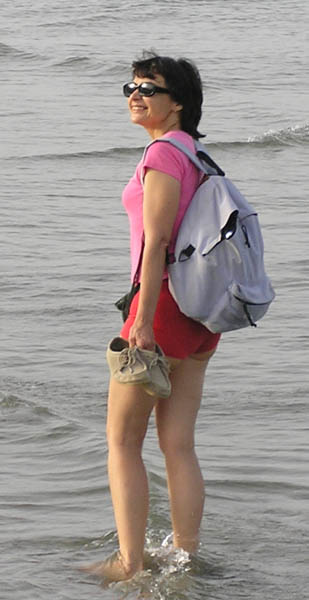Croatian alumna talks about science in newest member state

Sanja Tomic enjoys a paddle near Susak, one of Croatia’s islands
Croatian alumni returning to their home country now find themselves taking their skills back to the newest EMBL member state. We caught up with one of them, Sanja Tomic, to ask about her experiences at EMBL and the situation in general for scientists coming from Croatia. Sanja, formerly a postdoc in Rebecca Wade’s group, is now a higher research associate at the Ruder Boskovic Institute in Zagreb, in particular looking at the development of new algorithms to study protein-protein docking.
Is it easy to get into science in Croatia? Is science taught well in school?
Education is constantly improving. There’s little access to materials, though, so it mostly relies on teachers’ skills. But after school, it’s not easy to continue a career in science. There are a very small number of positions available.
How did you find out about EMBL before you came here?
I already had a collaboration with Rebecca, who was a group leader at EMBL. Until now, EMBL hasn’t been so well known in Croatia, but that’s changing. It’s great that Croatia has become a Member State because more scientists will have a chance to come here, and Croatia will be able to become more involved in European science as a whole.
How easy was it to get funding?
I was lucky – I came with a fellowship from the Alexander von Humboldt Foundation, which allows post-doctoral foreign scientists under 40 to spend a long-term stay doing research in Germany.
What was your area of study?
I was working on 3D QSAR (quantitative structure activity relationships), classifying small auxin (plant hormone) related molecules according to the similarity of their molecular interaction fields. I used force field-based methods and simulated conformational changes in molecules, studying the specificity of binding between transcription factors and DNA.
How has your career benefited from your time at EMBL?
It has benefited significantly. I learned so many new things, and what’s perhaps even more important, I was introduced to another working system and environment.
What advantages did you have here that you might not have had in Croatia?
It was great to be able to use the advanced techniques and up-to-date equipment available at EMBL, and I had access to almost all the scientific journals I needed. You have to be very established in your scientific career in Croatia in order to have access to the latest in technology and materials.
What would be your advice to other Croatian pre- or postdocs wanting to apply to come to EMBL?
Any helpful tips? EMBL is certainly an excellent place for working in science and I can recommend it to all young scientists. Voluntary work at an institute like the one I’m at now, the Ruder Boskovic Institute, or in a university might help provide useful lab experience first.
Finally, what do you miss about EMBL?
Our group – it was really international, with scientists from France, Germany, Italy, India, Russia, Belgium and the UK, and we all were really good friends. I am still in contact with most of them and am continuing to collaborate with Rebecca, who has also left now.